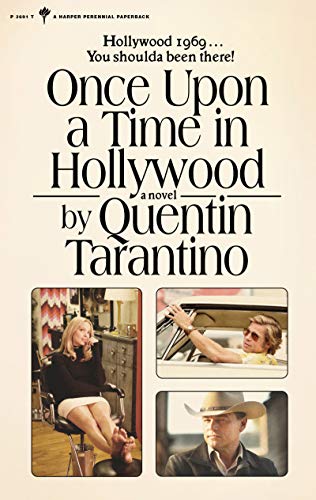While novelizations of popular movies have long existed (especially before the advent of home video), Quentin Tarantino’s novelization of Once Upon a Time in Hollywood is the first example I can find of a filmmaker adapting their own movie for the page. Alright, let’s not get too far into Auteur theory here; filmmaking is an inherently collaborative medium, but few would dispute that Tarantino was the true guiding force of the film. So this adaptation has an inherent hook that the usual, perhaps unfairly maligned, novelizations don’t. Given Tarantino’s infamous obsession with all things movie, it’s not surprising that he has an appreciation for the genre: “In the seventies movie novelizations were the first adult books I grew up reading … And to this day I have a tremendous amount of affection for the genre.”
I’ve grown to appreciate the movie more with each rewatch. What initially seems like a disjointed mélange of episodic story elements is actually tied together pretty well, if not in an immediately obvious way. The book puts the movie’s plotting in stark relief. There are digressions galore here, and not all of them are strictly necessary. Authors often claim that they have backstories and other context that guides their work without ever being explicitly laid out anywhere. Your mileage may vary as to whether you like seeing that or not.
Regardless, Tarantino is able to indulge in numerous backstories here, from Cliff Booth’s war record, to his postwar years, to a few times he got away with murder, to how he came to own his exceedingly well behaved pit bull Brandy, to his film buff tendencies and how he fell in love with Kurosawa but didn’t love Truffaut. We get full chapters and backstory about Charles Manson (who is only tangentially in the film), a description of the hallowed Manson girl tradition of the “creepy crawl,” and lots more about Sharon Tate and even future fugitive child rapist Roman Polanski. There’s even a sorta novelization-within-a-novelization, as Tarantino retells the entire Lancer pilot (interspersed with the actors talking about the pilot).
There’s the copious (and I mean copious) discussions about mid-century cinema and television. At times, the novel feels a little like a sorta profane non-fiction book as Tarantino recounts the various histories and anecdotes of actors, directors, movies, and television shows. Do you want to read ten pages about Aldo Ray’s alcoholism, or the general alcoholism that pervaded throughout Hollywood during that era? You got it. Do you want to know the lineage of western TV shows in the 60s? You got it. And on and on (and on!) While he mixes his fictional characters into history here, you will find out a lot more about the era than you ever wanted to know. I enjoyed this aspect of the novel, even if it sometimes takes the punch out of the pacing or plot, but some might find it a little too indulgent and distracting.
Stylistically, Tarantino isn’t going for anything highfalutin. He’s shooting for pulpy and profane, and for the most part he succeeds. Some have compared it to Elmore Leonard, but that doesn’t really do Tarantino any favors – few can stand up to that comparison and while there are times that Tarantino approaches Leonard, he doesn’t quite have that cadence down. Leonard certainly doesn’t descend into digressions and plots things much tighter, and his command of language is perhaps better suited for the medium. Tarantino is famous for his amazing scripts, but that’s a different medium. As a debut, this is fantastic stuff, but to say he got to Leonard’s level right out of the gate is perhaps too charitable. That said, I’m looking forward to more Tarantino novels. I think he could grow into the form quite well…
There’s some interesting structural twists to the plotting as well. He does this thing where he’ll suddenly flash backwards or forwards for long swaths of time. Indeed, the bombastic ending of the film is a just sorta tossed off flash-forward reference about 1/4 of the way into the book. The other big set-piece from the movie, Cliff Booth’s tension-filled visit to Spahn ranch is retained partially in-tact, and Taratino nails the atmosphere, but the sequence in the film is certainly more harrowing. The book’s end actually works surprisingly well for what it is, though I don’t know that it’s better than the film.
All in all, it’s a fascinating little book and worth a look if you liked the movie. There’s lots to chew on and plenty of differences, big and small, that make this a distinct enough experience to be worthwhile. Personally, the book made me appreciate the movie even more. The book retains the movie’s ultimate hangout vibe, so while the book perhaps isn’t for everyone, there’s still lots there to enjoy.
